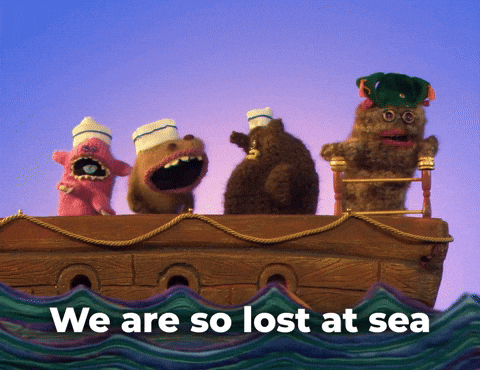How Getting Lost Led Me to My Life's Work
How I stopped chasing every design trend and found my actual calling
If you told me 8 years ago that I'd be living in Barcelona, working remotely as a senior product designer with my amazing wife and two cats, I'd have probably asked if you had me confused with someone who had their life together.
Where it all began
University left me adrift. I studied "Information Technology Management", a degree that made me mediocre at both business and tech. Graduation hit like a reality check: I wasn't qualified for anything meaningful.
After a soul-crushing IT internship (yes, I asked people to turn it off and on again), I bounced around. Personal trainer, then QA tester making $2.2k while friends scraped by on $1.5k. I felt successful, but that familiar dread crept in: What if I become that 40-year-old guy still bragging about achievements from decades ago?
The discovery
Then I found Product Design through Chris Do's "The Futur" YouTube channel. Something clicked.
I went obsessive. I followed every designer, consumed every podcast, watched every free course. I was marinated in design content. It gave me hope and something to wake up for.
I started copying designs, adding my own twists, redesigning favorite games and shows as websites. Those playful mock-ups landed my first UX job.
The pattern emerges
Working on an e-commerce site, I dove deep into Baymard Institute research and pushed for improvements. The managers couldn't handle a newcomer making waves, but I felt that familiar emptiness again. I was destined for more.
I partnered with an amazing designer—we made every moment about learning and growing. (We became best friends and still work together today.) I quit that job with a promise to myself: I'd never work on anything that crushed my soul, even if it meant no money. You can read his side of his story here.
Finding my place
Lucky enough, I landed my dream job at CME. Four years later, I've grown tremendously. But as a senior designer approaching principal level, that old pattern returned—lost and confused by the sheer volume of content, distractions, and shiny objects online.
Even with my dream job and dream life in Barcelona, I was drowning in noise.
The irony of success
Here's the kicker: I had everything I thought I wanted, yet I felt more lost than ever. Every morning I'd open LinkedIn to find 47 "game-changing" design frameworks, 12 "revolutionary" AI tools, and countless posts about how I should be thinking about design differently.
I'd bookmark articles I'd never read, save Instagram posts about "design systems that scale" (whatever that means), and sign up for newsletters that promised to "10x my design career" (spoiler: they didn't).
The paradox was maddening—the more successful I became, the more I questioned everything. Was I falling behind? Should I learn all those new AI tools? What about vibe coding? Maybe I needed to pivot to product strategy? Or should I become a design systems specialist?
The breaking point
The worst part? I started second-guessing decisions I'd made confidently for years. Simple design choices became existential crises. "Is this button really solving the user's problem, or am I just following some outdated pattern I learned three years ago?"
I threw money at the problem like it was on fire. $1,200 on courses promising to "unlock my design potential." Another $800+ on books that would supposedly reveal the "secrets of successful designers." My library looked like a design self-help graveyard. (also shipping this many books between countries wasn’t a very fun experience).
I booked ADPlist sessions, cold-messaged designers on LinkedIn, from Silicon valley veterans to scrappy startup founders. Everyone had opinions, but no one had complete answers. The advice was either too generic ("build a great portfolio") or too specific to their unique situation.
I was that person refreshing Twitter at 2 AM looking for design inspiration, only to find more confusion disguised as wisdom. The irony? I was spending more on learning about design than actually designing.
I'd spend hours watching YouTube videos about "the future of UX" and “Will Ai replace us”. I had tabs open for courses I'd bought but never finished, design books I'd ordered but never opened, and a growing sense that everyone else had figured out something I was missing.
The full circle moment
That's when it hit me: I was experiencing the exact same feeling I had in university. Feeling lost, overwhelmed, and desperately seeking direction. Except this time, instead of not knowing what I wanted to do, I was drowning in too many options of what I could do.
The solution became obvious. Just like Chris Do's focused content saved me from career confusion, I needed to create that same clarity for others drowning in design noise.
The solution
"Refine" isn't just a platform—it's my attempt to solve the problem that's haunted me my entire career. It's the complete resource I wish existed during those $2,000 learning binges and 2 AM existential design crises.
No more "5 AI tools that will change everything" lists. No more frameworks with fancy names that solve problems you don't have. Just clear, actionable guidance for designers who want to grow without losing their sanity or their savings account.
It's the resource I wish existed during those 2 AM existential design crises—a place where clarity wins over clicks, and substance beats the latest shiny trend.
What's next
I'll be sharing regular updates on this journey, all the successes, failures, and everything in between. Building Refine is my way of ensuring no other designer has to navigate this overwhelming landscape alone.
Because sometimes the best way forward is to help others find their path too.
The platform is being built as you are reading this!







